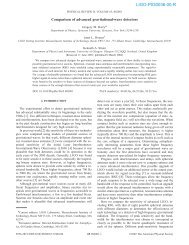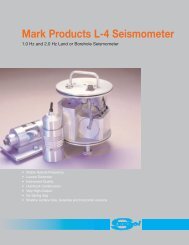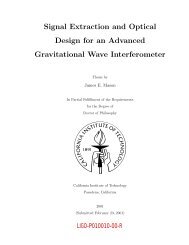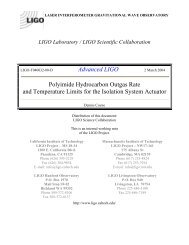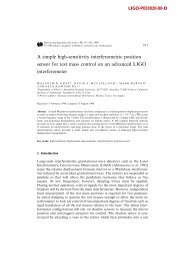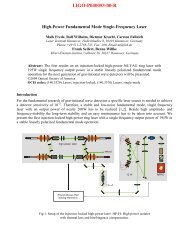for the sqfe use of lqsers - LIGO
for the sqfe use of lqsers - LIGO
for the sqfe use of lqsers - LIGO
You also want an ePaper? Increase the reach of your titles
YUMPU automatically turns print PDFs into web optimized ePapers that Google loves.
APPENDIX<br />
NOTE 3: For rectangular or elliptical beams see 84.7.<br />
Example I7'. Find <strong>the</strong> radiant exposure at I km<br />
(105 cm) from a O.lJ Q switched ruby laser (pulse<br />
length = 20 ns) which has a beam div€rgence <strong>of</strong><br />
I mrad (lfr rad) and an emergent beam diameter <strong>of</strong><br />
0.7 cm. Using !t = l0-7 cm-r to provide a worst case<br />
estimate,<br />
"<br />
'J =<br />
, ,rrn , ,,_fl0 ' )rtd )<br />
jj:j-:::j=-<br />
(0.7 + 1t05;116-111:<br />
_ (1.27) (0.1) (0.ee)<br />
(0.7 + 100)2<br />
= 1.25 x l0-5 J . cm-2<br />
84.2.1 Norninal Ocular Hazrrd Distance<br />
(NOHD).<br />
If <strong>the</strong> atmospheric attenuation coefficient is<br />
neglected, a worst case estimate <strong>of</strong> <strong>the</strong> NOHD<br />
(rM<strong>of</strong>lD) <strong>for</strong> Example l7 can be calculated from:<br />
1<br />
rNoHD =<br />
6<br />
o [,_ I<br />
=# h/+*P -.'J<br />
( 5.M km<br />
84,2.2 Range Nomogram, Fig, 86.<br />
The range nomogram in Fig. 86 (which includes <strong>the</strong><br />
attenuation coefficient) can also be <strong>use</strong>d to determine<br />
rNoHD. For <strong>the</strong> values given in Example 17, draw a<br />
line between l00mJ and l.0mrad. This line intercepts<br />
<strong>the</strong> "lntegrated Radiant lntensity" scale at<br />
approximately 0.13 MJ ' s.'. A line is <strong>the</strong>n drawn<br />
from <strong>the</strong> above point to 0.5 lrJ.cm-z on <strong>the</strong> "Radiant<br />
Exposure" scale, intercepting <strong>the</strong> "Range" scale<br />
at 4.9 km <strong>for</strong> a clear day and 4 km <strong>for</strong> a hazy day.<br />
84,3 Bearn Diameter.<br />
The minimum beam diameter. <strong>for</strong> a small 0 at range<br />
r, is given by F4 84:<br />
Dt=a +Qr<br />
Example 18: Find <strong>the</strong> diameter <strong>of</strong> a laser beam at<br />
l km where <strong>the</strong> emergent beam diameter is lOcm<br />
and <strong>the</strong> beam divergence is 0.1 mrad.<br />
66<br />
Dr = l0 cm + (l0r rad) (105 cm)<br />
P1<br />
E=<br />
tD cosO"<br />
or<br />
H=<br />
and<br />
= l0+ l0=20cm<br />
84,4 Diff<strong>use</strong> Refl ections.<br />
The reflected irradiance or radiant exposure <strong>for</strong> a dif.<br />
f<strong>use</strong> reflector (<strong>for</strong> rl :> D.) is given by<br />
--;4-<br />
pr O cos0"<br />
--;i-<br />
{@=,,.,".<br />
'(rr)(10-")<br />
(Eqs Bl0<br />
Example 19: Find <strong>the</strong> maximum rcflected mdiad<br />
exposure at a point along <strong>the</strong> beam axis <strong>of</strong> a 0.1 I<br />
laser, lOm from a diff<strong>use</strong> matte <strong>of</strong> reflectance 0.6 .<br />
(cos 0l = 1).<br />
H_<br />
(0.1J)(9.6),<br />
= 1.9t x tga J.cm-2<br />
(3.14) (10' cm)'<br />
Example 20: Find <strong>the</strong> minimum safe viewing distane<br />
<strong>for</strong> looking at a diff<strong>use</strong> target having a rcflectivity<br />
P;, = 0.9 from a laboratory Ar laser with O = 2W and<br />
d = 2 mm (assume a l0 s exposure duration). (fhis is<br />
also <strong>the</strong> border <strong>of</strong> <strong>the</strong> NHZ, see Fig. B4). The emergent<br />
beam irradiance is 6^3.7 W.cm-2 which ir<br />
greater than <strong>the</strong> 6,8 W 'cm-' maximum permissible<br />
irradiance incident on a 100 percent diff<strong>use</strong>ly<br />
reflecting surface <strong>for</strong> a lOs exposure duration (s€e<br />
TableBl). It is <strong>the</strong>re<strong>for</strong>e concluded that 4vflz must<br />
be greater than Dllohin and intmbeam MPEs apply.<br />
Hence, <strong>the</strong> l0 s MPE is I x l0-3 w'cm-2 (Table 5<br />
or Fig. 4) and <strong>the</strong> expression <strong>for</strong> rpsT can be found by<br />
reananging Eq Bl0. Hence<br />
(Eq BI0a)<br />
Figure 86 may also be <strong>use</strong>d to determine this distance<br />
graphically.




